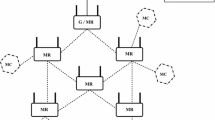Abstract
Wi-Fi networks often consist of several Access Points (APs) to form an Extended Service Set. These APs may interfere with each other as soon as they use the same channel or overlapping channels. A classical model to describe interference is the conflict graph. As the interference level varies in the network and in time, we consider a weighted conflict graph. In this paper, we propose a method to infer the weights of the conflict graph of a Wi-Fi network. Weights represent the proportion of activity from a neighbor detected by the Clear Channel Assessment mechanism. Our method relies on a theoretical model based on Markov networks applied to a decomposition of the original conflict graph. The input of our solution is the activity measured at each AP, measurements available in practice. The proposed method is validated through ns-3 simulations performed for different scenarios. Results show that our solution is able to accurately estimate the weights of the conflict graph.
Access this chapter
Tax calculation will be finalised at checkout
Purchases are for personal use only
Similar content being viewed by others
References
Network simulator version 3 (ns-3). https://www.nsnam.org/
Amer, M., Busson, A., Guérin-Lassous, I.: Association optimization in Wi-Fi networks based on the channel busy time estimation. In: IFIP Networking (2018)
Cai, K., Blackstock, M., Feeley, M.J., Krasic, C.: Non-intrusive, dynamic interference detection for 802.11 networks. In: Proceedings of the 9th ACM SIGCOMM Internet Measurement Conference, IMC 2009, Chicago, Illinois, USA, 4–6 November 2009, pp. 377–383 (2009)
Calhoun, P., Montemurro, M., Stanley, D.: Control and provisioning of wireless access points (CAPWAP) protocol specification. RFC 5415, RFC Editor (2009). http://www.rfc-editor.org/rfc/rfc5415.txt
Chounos, K., Keranidis, S., Korakis, T., Tassiulas, L.: Characterizing the impact of interference through spectral analysis on commercial 802.11 devices. In: IEEE International Conference on Communications, ICC 2017, Paris, France, 21–25 May 2017, pp. 1–6 (2017)
Cui, Y., Li, W., Cheng, X.: Partially overlapping channel assignment based on “node orthogonality” for 802.11 wireless networks. In: 2011 Proceedings IEEE INFOCOM, pp. 361–365 (2011). https://doi.org/10.1109/INFCOM.2011.5935182
Dhoutaut, D., Guérin-Lassous, I.: Experiments with 802.11b in ad hoc configurations. In: Proceedings of the IEEE 14th International Symposium on Personal, Indoor and Mobile Radio Communications, PIMRC 2003, Beijing, China, 7–10 September 2003, pp. 1618–1622 (2003)
Ding, Y., Huang, Y., Zeng, G., Xiao, L.: Channel assignment with partially overlapping channels in wireless mesh networks. In: Proceedings of the 4th Annual International Conference on Wireless Internet, WICON 2008, pp. 38:1–38:9. ICST (Institute for Computer Sciences, Social-Informatics and Telecommunications Engineering), ICST, Brussels, Belgium, Belgium (2008). http://dl.acm.org/citation.cfm?id=1554126.1554173
Grünblatt, R., Guérin-Lassous, I., Simonin, O.: Study of the Intel WiFi rate adaptation algorithm. In: CoRes 2019, pp. 1–4 (2019)
Jang, S., Bahk, S.: A channel allocation algorithm for reducing the channel sensing/reserving asymmetry in 802.11ac networks. IEEE Trans. Mob. Comput. 14(3), 458–472 (2015)
Kala, S.M., Reddy, M.P.K., Musham, R., Tamma, B.R.: Interference mitigation in wireless mesh networks through radio co-location aware conflict graphs. Wirel. Netw. 22(2), 679–702 (2016)
Li, W., Zhang, J., Zhao, Y.: Conflict graph embedding for wireless network optimization. In: 2017 IEEE Conference on Computer Communications, INFOCOM 2017, Atlanta, GA, USA, 1–4 May 2017, pp. 1–9 (2017)
Magistretti, E., Gurewitz, O., Knightly, E.W.: Inferring and mitigating a link’s hindering transmissions in managed 802.11 wireless networks. In: Proceedings of the 16th Annual International Conference on Mobile Computing and Networking, MOBICOM 2010, Chicago, Illinois, USA, 20–24 September 2010, pp. 305–316 (2010)
Paul, U., Kashyap, A., Maheshwari, R., Das, S.R.: Passive measurement of interference in WiFi networks with application in misbehavior detection. IEEE Trans. Mob. Comput. 12(3), 434–446 (2013)
Zhou, X., Zhang, Z., Wang, G., Yu, X., Zhao, B.Y., Zheng, H.: Practical conflict graphs in the wild. IEEE/ACM Trans. Netw. 23(3), 824–835 (2015)
Author information
Authors and Affiliations
Corresponding author
Editor information
Editors and Affiliations
Rights and permissions
Copyright information
© 2019 Springer Nature Switzerland AG
About this paper
Cite this paper
Abdewedoud, L., Busson, A., Guérin-Lassous, I., Foare, M. (2019). A Passive Method to Infer the Weighted Conflict Graph of an IEEE 802.11 Network. In: Palattella, M., Scanzio, S., Coleri Ergen, S. (eds) Ad-Hoc, Mobile, and Wireless Networks. ADHOC-NOW 2019. Lecture Notes in Computer Science(), vol 11803. Springer, Cham. https://doi.org/10.1007/978-3-030-31831-4_21
Download citation
DOI: https://doi.org/10.1007/978-3-030-31831-4_21
Published:
Publisher Name: Springer, Cham
Print ISBN: 978-3-030-31830-7
Online ISBN: 978-3-030-31831-4
eBook Packages: Computer ScienceComputer Science (R0)




